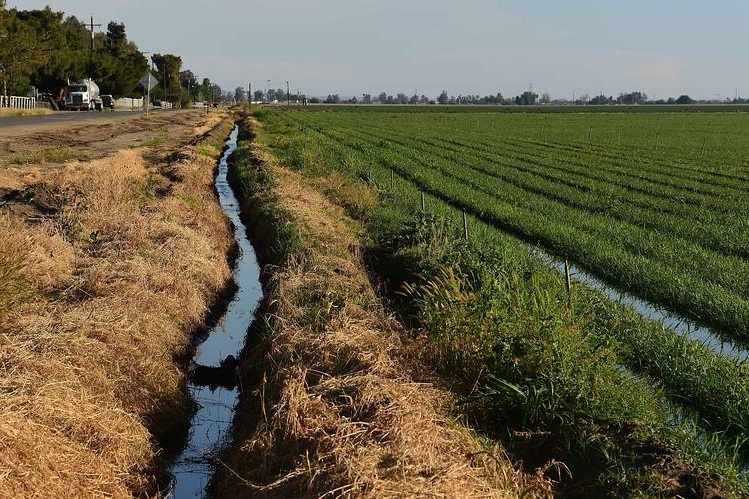Are You Eating Food That Was Irrigated With Oilfield Wastewater? Toxic Oilfield Wastewater Used to Grow California Food, Including Organics

Food & Water Watch is launching a campaign to ban the practice, which threatens our food, farm workers and the environment, with a new documentary by noted filmmaker Jon Bowermaster and a campaign video capturing shocked reactions from people who previewed the video last week in front of Whole Foods’ headquarters in Austin, Texas.
The produce industry’s dirty secret: toxic oil wastewater is being used to grow our food
Oil companies in California are selling wastewater from their drilling operations to several local irrigation districts, which in turn mix it with the water they sell to growers to irrigate their crops.
This sounds complicated, but what it means is that the toxic wastewater, which could include up to 173 different chemicals, ends up in the water used to irrigate popular crops that are shipped across the country. A lot of the fruits, veggies and wines irrigated in this area are going to look familiar — like Halos Mandarin oranges, a popular snack marketed as being “pure goodness.”
“People are outraged, especially parents, when they find out the products they’re buying, sometimes organic, are actually being raised with oil and gas wastewater.” –Wenonah Hauter
Four water districts in the Central Valley use this toxic water. But with such a neat way for the oil and gas industry to dispose of their noxious wastewater (not to mention looming water shortages) it isn’t hard to imagine this becoming industry standard. It’s not clear whether the practice may already be going on in other states.
A lot of these fruits and veggies are grown with toxic wastewater are the same ones we feed our children
In the video below, you can see the shocked reactions of shoppers as they watch the mini-documentary. The consensus? We just need to ban it.
Global use of wastewater to irrigate agriculture at least 50 percent greater than thought
The use of untreated wastewater from cities to irrigate crops downstream is 50 percent more widespread than previously thought, according to a new study published in the journal Environmental Research Letters.
The study relies on advanced modeling methods to provide the first truly comprehensive estimate of the global extent to which farmers use urban wastewater on irrigated cropland. Researchers analyzed data with geographic information systems (GIS) rather than depending on case study results, as in previous studies.
The researchers also assessed for the first time ‘indirect reuse’, which occurs when wastewater gets diluted but still remains a dominant component of surface water flows. Such situations account for the majority of agricultural water reuse worldwide, but have been difficult to quantify on a global level due to different views of what constitutes diluted wastewater versus polluted water.
Considering consumer safety the foremost priority, study authors highlight the need to mitigate public health risks through measures taken along the entire food supply chain. This includes improved wastewater treatment, but also preventive steps on farms and in food handling, since capacity for water treatment is increasing only slowly in developing countries.
According to the study, farmers’ use of wastewater is most prevalent in regions where there is significant wastewater generation and water pollution. In these circumstances, and where safer water is in short supply, wastewater offers a consistent and reliable means of irrigating fields, including high-value crops, such as vegetables, which often require more water than staple foods. Where raw wastewater is available, farmers may tend to prefer it because of its high concentrations of nutrients, which can lessen the need to apply purchased fertilizers. In most cases, however, farmers’ use of this water is motivated by basic needs; they simply do not have alternatives.
“The de facto reuse of urban wastewater is understandable, given the combination of increasing water pollution and declining freshwater availability, as seen in many developing countries,” said Anne Thebo, a recent graduate at the University of California, Berkeley in the USA and lead author of the study. “As long as investment in wastewater treatment lags far behind population growth, large numbers of consumers eating raw produce will face heightened threats to food safety.”
Results show that 65 percent of all irrigated areas are within 40 km downstream of urban centers and are affected by wastewater flows to a large degree. Of the total area of 35.9 million hectares, 29.3 million hectares are in countries with very limited wastewater treatment, exposing 885 million urban consumers as well as farmers and food vendors to serious health risks. Five countries – China, India, Pakistan, Mexico and Iran – account for most of this cropland. These new findings supersede a widely cited 2004 estimate, based on case studies in some 70 countries and expert opinion, which had put the cropland area irrigated with wastewater at a maximum of 20 million hectares.
“Gaining a better grasp of where, why and to what extent farmers use wastewater for irrigation is an important step toward addressing the problem,” said second author Pay Drechsel of the International Water Management Institute (IWMI), who leads the CGIAR Research Program on Water, Land and Ecosystems. “While actions aimed at protecting human health are the first priority, we can also limit the hazards through a variety of tested approaches aimed at safely recovering and reusing valuable resources from wastewater. These include the water itself but also energy, organic matter and nutrients, all of which agriculture needs. Through such approaches, we have been helping the World Health Organisation (WHO) respond to the wastewater challenge over the years.”
“We hope this new study will focus the attention of policy makers and sanitation experts on the need to fulfill Sustainable Development Goal 6, particularly target 3, which calls for halving the proportion of untreated wastewater, and increasing recycling and safe water reuse,” added Drechsel.
Source: www.foodandwaterwatch.org



1 Comment
Andykaufmantony · August 22, 2018 at 6:14 pm
Maggie, thanks! And thanks for sharing your great posts every week!
Comments are closed.